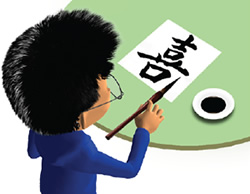Letter writing is a timeless form of communication. Although letter writing has decreased in popularity since the introduction of the internet and mobile phones, people still appreciate the excitement of receiving a letter in the mail.
The history of communication

Communication is essential to the way that we live our lives. Over time, humans have tried and tested many different modes of communication. Writing letters might seem like an old fashioned method of communication, but really it is timeless. It will always be exciting to come home and find an envelope with your name on it waiting for you in the letterbox.
There are ways of communication that are a lot older and were practiced within ancient societies, as well as some more modern attempts at communication you might not have heard of before.
Read below to find out about the history of communication.
- The modern English alphabet was completed in the 16th century (only 500 years ago) when ‘w’ became an independent letter and ‘u’ and ‘j’ were added. Compared to Egyptian hieroglyphics that date back to before 3000 BC and the Phoenician alphabet from 1050 BC, the English language is very young.
- Before paper was invented by the Chinese in 105 AD, people drew on cave walls or wrote on stone tablets, bark, pottery, or papyrus. Papyrus is an old form of paper. The Egyptians would make sheets from the papyrus plant that grew alongside the River Nile.
- Before pens, people wrote with sharpened bones or sticks, or feather quills dipped in ink.
- In the 1440s a German named Johannes Gutenberg invented the printing press, meaning that texts could easily be printed and distributed. One of the next major inventions aiding communication came in the mid-twentieth century: the internet.
- Throughout history, messengers on foot or on horseback, smoke signals and even pigeons, dogs, camels and reindeer have all been used to deliver messages.
- Braille (a series of bumps which can be ‘read’ by touch) is a way for people who are blind or visually impaired to communicate. It is named after its inventor; a Frenchman named Louis Braille, and is based on a system of silent communication which was intended for use by Napoleon’s army.
- Many ancient civilizations, such as the Ancient Greeks, relied on oral (spoken) communication to relate stories, myths and legends. The Australian Aboriginal Dreamtime stories are also told orally. In modern times, we often retell nursery rhymes, jokes and lullabies orally.
- The world’s first text message was sent in 1992. In 1995 people were sending an average of one text a month. Meanwhile, today, text messaging is hugely popular – it is estimated that around 16 million text messages are sent a minute which is about 23 billion per day!
Letter writing fast facts

- Throughout history, famous and iconic figures have put pen to paper and written letters. Letters from the famous composer Ludwig Van Beethoven, the author Ernest Hemingway and King Henry VIII still exist today, providing us with glimpses into their personal lives.
- Envelopes are not just for letters. In China, on special occasions, such as weddings or Chinese New Year, people give money in bright red envelopes decorated with gold Chinese characters meaning happiness and wealth.
- In the past, paper was so expensive that instead of using an envelope, people would save money by folding their letters and sealing them with wax.
- The first envelopes were made by the ancient Babylonians about 5000 years ago. Unlike our modern day paper envelopes, these were made out of baked clay!
- Envelopes seem pretty simple, but have you ever considered how they have changed over the years? Envelopes were originally cut from sheets of paper and sealed by hand. Now we have large machines that bulk produce envelopes with a clear plastic window and a gummed tab to seal the envelope.
- In the Middle Ages, very few Europeans could read or write. In fact, it was generally only monks and members of the nobility who possessed these skills.

- Many cultures, including Japanese, Chinese and Arabic, practice calligraphy (a style of decorative or artistic handwriting). Calligraphy is considered an art form and is often deeply tied to spirituality as well as harmony between the calligrapher and their writing instruments.
References
The following link will direct you to the homepage of the website used as reference for this topic.
- Australia Post: auspost.com.au




